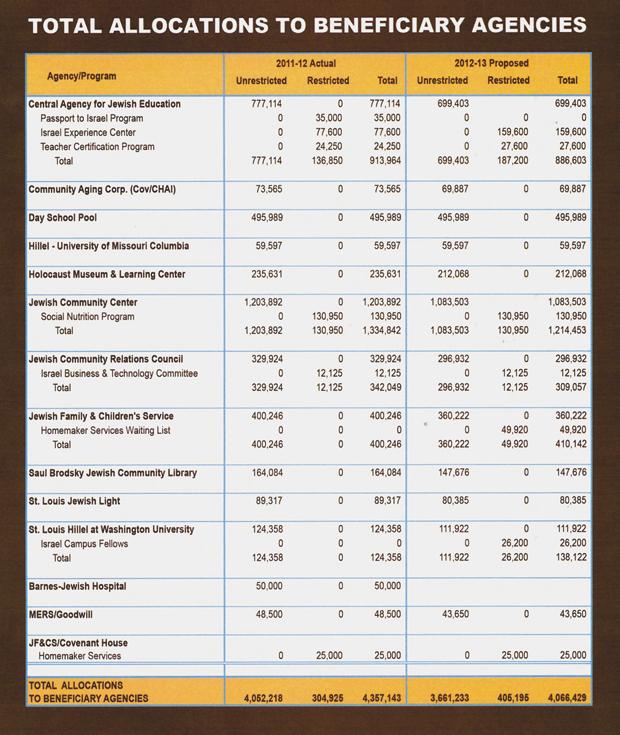Federation allocations show shift to more targeted giving
Published June 20, 2012
As the year’s allocation process draws to a close, the Jewish Federation of St. Louis finds itself both tightening its belt and making changes to its funding model that may significantly affect the way money is doled out to the community in the future.
According to the agency’s 2012 Planning & Allocations Committee Report released last week, the Federation will distribute just over $8.5 million, a 6.5 percent drop over last year’s figures with a number of prominent beneficiaries losing a tenth of their unrestricted dollars. The unrestricted budget for local beneficiaries shrunk from over $4 million to less than $3.7 million.
ADVERTISEMENT
The numbers come on the heels of a series of sagging annual campaigns that have plagued the organization since the economic crisis. The Federation announced in January it had raised $9.4 million, the lowest figure seen in more than a decade.
But the new numbers also represent a significant change in decision making for the umbrella agency, which has begun an effort to shift more dollars away from unrestricted allocations in order to hardwire it toward programmatic grants that further the overall mission.
“Whereas Federation’s previous role was to aggregate charitable dollars, its new role includes helping to shape a vision for the St. Louis Jewish community,” read a message introducing the report. “Implicit in this change is a shift in the focus of Federation fundraising and allocations, from supporting agencies per se to supporting agencies and programs that meet the goals and objectives of the strategic plan.”
Despite the overall decline in cash, strategic program grants broke $2 million, increasing by close to a fifth over last year. The category now represents nearly 24 percent of the funds versus just over 19 percent in 2011. Those dollars were divided among four subcommittees with nearly half going to the “Ensuring the Jewish Future” section, which deals with a number of items including two Federation strategic plan priorities — strengthening the Jewish identity of future generations and creating community for young adults and families with young children. That subcommittee saw a hefty 31 percent boost leaving it above $960,000, more than tenth of the total allocations.
ADVERTISEMENT
Two of the other subcommittees were increased as well. “Caring for Jews in Need — Domestic” saw a boost of 15 percent while the smallest category, “Community Engagement,” was bolstered by more than half, topping $110,000. The remaining set of priorities — related to Jews in need overseas —remained steady at just over half a million dollars.
Meanwhile, on the other side of the ledger unrestricted giving fell by more than 12 percent to just over $6 million with local agencies, representing about 43 percent of total dollars, taking the smallest hit by shedding a tenth of their unrestricted monies. The next largest category, Israel and overseas, fell by 15 percent while national agencies, making up only one percent of the budget, ebbed by more than a quarter.
Overall, unrestricted cash dropped by more than $800,000 while strategic program grants gained more than $300,000.
Interviewed just before leaving on a trip to Israel, Jewish Federation President and CEO Barry Rosenberg (see Rosenberg’s related commentary on page 9A) said the new focus was an attempt to ensure that money was targeted to the areas where it was needed the most.
“We are working to ensure that precious and limited philanthropic dollars are directed to the highest priority needs of the Jewish community,” he said. “One of the strategies for doing that is shifting the ratio from unrestricted to strategic grants.”
Michael Oberlander said the process was the result of both formal and informal meetings with leaders from agencies and the community.
“The move toward strategic planning grants has been part of Federation’s long-term plan of freeing up resources to be able to make strategic program grants,” said Oberlander, vice chair of the Planning and Allocations Committee, in a Federation press release. “And with the decrease in available funds, we needed to make difficult but necessary shifts from unrestricted allocations to the specific strategic program grants.”
Numerous organizations under the Federation umbrella will lose one-tenth of their unrestricted dollars including the Central Agency for Jewish Education, the St. Louis Hillel at Washington University, the Holocaust Museum and Learning Center, the Jewish Community Relations Council, Jewish Family & Children’s Service, the Jewish Community Center, the Saul Brodsky Jewish Community Library, MERS/Goodwill and the St. Louis Jewish Light. Some however, including CAJE, JF&CS and Hillel, will see substantial increases to restricted funds cushioning that blow.
The program grants will go to create or grow a wide variety of initiatives including greater support for young adult programs like Next Dor, Moishe House, the Karen Solomon Young Adult Initiative and Birthright Israel. Other programs will include the creation of an Innovation Fund for Jewish social entrepreneurs and increased funding to meet the needs of homemaker services for the low-income elderly, something Rosenberg said was important to fill holes created by state funding cuts.
Israel identity dollars will go to support groups in the Jewish State that promote empowerment of women, at-risk children and youth and assist victims of terror as well as to help develop a pluralistic Reform community in Yokneam-Megiddo and to boost the number of local non-Jewish leaders who visit Israel.
“We want to better expose them to the story of Israel, not just what they read in the newspapers,” Rosenberg said.
The Federation release said the restructuring of the allocations process will be phased in over two to three years with periodic reviews.
Meanwhile, Rosenberg said that more donations are still needed to boost Federation fundraising.
“Any decrease in funding is a serious matter for the community,” he said. “It means less dollars to meet critical services at a moment when demand is increasing. The critical factor for the community is to raise more funds through the annual campaign.”















